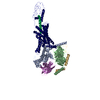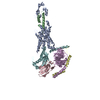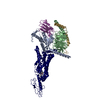登録情報 データベース : PDB / ID : 6wzgタイトル Human secretin receptor Gs complex (Guanine nucleotide-binding protein ...) x 3 Nanobody35 Secretin Secretin receptor キーワード / / / 機能・相同性 分子機能 ドメイン・相同性 構成要素
/ / / / / / / / / / / / / / / / / / / / / / / / / / / / / / / / / / / / / / / / / / / / / / / / / / / / / / / / / / / / / / / / / / / / / / / / / / / / / / / / / / / / / / / / / / / / / / / / / / / / / / / / / / / / / / / / / / / / / / / / / / / / / / / / / / / / / / / / / / / / / / / / / / / / / / / / / / / / / / / / / / / / / / / / / / / 生物種 Homo sapiens (ヒト)Lama glama (ラマ)手法 / / / 解像度 : 2.3 Å データ登録者 Piper, S.J. / Belousoff, M.J. / Danev, R. 資金援助 組織 認可番号 国 National Institutes of Health/National Institute of Diabetes and Digestive and Kidney Disease (NIH/NIDDK) GM-132095 National Health and Medical Research Council (NHMRC, Australia) 1120919 National Health and Medical Research Council (NHMRC, Australia) 1150083 Royal Society BB/M006883/1
ジャーナル : Nat Commun / 年 : 2020タイトル : Structure and dynamics of the active Gs-coupled human secretin receptor.著者: Maoqing Dong / Giuseppe Deganutti / Sarah J Piper / Yi-Lynn Liang / Maryam Khoshouei / Matthew J Belousoff / Kaleeckal G Harikumar / Christopher A Reynolds / Alisa Glukhova / Sebastian G B ... 著者 : Maoqing Dong / Giuseppe Deganutti / Sarah J Piper / Yi-Lynn Liang / Maryam Khoshouei / Matthew J Belousoff / Kaleeckal G Harikumar / Christopher A Reynolds / Alisa Glukhova / Sebastian G B Furness / Arthur Christopoulos / Radostin Danev / Denise Wootten / Patrick M Sexton / Laurence J Miller / 要旨 : The class B secretin GPCR (SecR) has broad physiological effects, with target potential for treatment of metabolic and cardiovascular disease. Molecular understanding of SecR binding and activation ... The class B secretin GPCR (SecR) has broad physiological effects, with target potential for treatment of metabolic and cardiovascular disease. Molecular understanding of SecR binding and activation is important for its therapeutic exploitation. We combined cryo-electron microscopy, molecular dynamics, and biochemical cross-linking to determine a 2.3 Å structure, and interrogate dynamics, of secretin bound to the SecR:Gs complex. SecR exhibited a unique organization of its extracellular domain (ECD) relative to its 7-transmembrane (TM) core, forming more extended interactions than other family members. Numerous polar interactions formed between secretin and the receptor extracellular loops (ECLs) and TM helices. Cysteine-cross-linking, cryo-electron microscopy multivariate analysis and molecular dynamics simulations revealed that interactions between peptide and receptor were dynamic, and suggested a model for initial peptide engagement where early interactions between the far N-terminus of the peptide and SecR ECL2 likely occur following initial binding of the peptide C-terminus to the ECD. 履歴 登録 2020年5月13日 登録サイト / 処理サイト 改定 1.0 2020年8月12日 Provider / タイプ 改定 1.1 2020年9月2日 Group / カテゴリ / citation_authorItem _citation.journal_volume / _citation.page_first ... _citation.journal_volume / _citation.page_first / _citation.page_last / _citation.pdbx_database_id_PubMed / _citation.title / _citation_author.name 改定 1.2 2024年10月23日 Group / Database references / Structure summaryカテゴリ chem_comp_atom / chem_comp_bond ... chem_comp_atom / chem_comp_bond / database_2 / em_admin / pdbx_entry_details / pdbx_modification_feature Item / _database_2.pdbx_database_accession / _em_admin.last_update
すべて表示 表示を減らす
 データを開く
データを開く 基本情報
基本情報 要素
要素 キーワード
キーワード 機能・相同性情報
機能・相同性情報 Homo sapiens (ヒト)
Homo sapiens (ヒト)
 データ登録者
データ登録者 米国,
米国,  オーストラリア,
オーストラリア,  英国, 4件
英国, 4件  引用
引用 ジャーナル: Nat Commun / 年: 2020
ジャーナル: Nat Commun / 年: 2020





 構造の表示
構造の表示 ムービービューア
ムービービューア Molmil
Molmil Jmol/JSmol
Jmol/JSmol ダウンロードとリンク
ダウンロードとリンク ダウンロード
ダウンロード 6wzg.cif.gz
6wzg.cif.gz PDBx/mmCIF形式
PDBx/mmCIF形式 pdb6wzg.ent.gz
pdb6wzg.ent.gz PDB形式
PDB形式 6wzg.json.gz
6wzg.json.gz PDBx/mmJSON形式
PDBx/mmJSON形式 その他のダウンロード
その他のダウンロード 6wzg_validation.pdf.gz
6wzg_validation.pdf.gz wwPDB検証レポート
wwPDB検証レポート 6wzg_full_validation.pdf.gz
6wzg_full_validation.pdf.gz 6wzg_validation.xml.gz
6wzg_validation.xml.gz 6wzg_validation.cif.gz
6wzg_validation.cif.gz https://data.pdbj.org/pub/pdb/validation_reports/wz/6wzg
https://data.pdbj.org/pub/pdb/validation_reports/wz/6wzg ftp://data.pdbj.org/pub/pdb/validation_reports/wz/6wzg
ftp://data.pdbj.org/pub/pdb/validation_reports/wz/6wzg リンク
リンク 集合体
集合体
 要素
要素 Homo sapiens (ヒト) / 遺伝子: GNAS, GNAS1, GSP / 発現宿主:
Homo sapiens (ヒト) / 遺伝子: GNAS, GNAS1, GSP / 発現宿主:  Trichoplusia ni (イラクサキンウワバ) / 参照: UniProt: P63092
Trichoplusia ni (イラクサキンウワバ) / 参照: UniProt: P63092 Homo sapiens (ヒト) / 遺伝子: GNB1 / 発現宿主:
Homo sapiens (ヒト) / 遺伝子: GNB1 / 発現宿主:  Trichoplusia ni (イラクサキンウワバ) / 参照: UniProt: P62873
Trichoplusia ni (イラクサキンウワバ) / 参照: UniProt: P62873 Homo sapiens (ヒト) / 遺伝子: GNG2 / 発現宿主:
Homo sapiens (ヒト) / 遺伝子: GNG2 / 発現宿主:  Trichoplusia ni (イラクサキンウワバ) / 参照: UniProt: P59768
Trichoplusia ni (イラクサキンウワバ) / 参照: UniProt: P59768 Homo sapiens (ヒト) / 参照: UniProt: P09683
Homo sapiens (ヒト) / 参照: UniProt: P09683 Homo sapiens (ヒト) / 遺伝子: SCTR / 発現宿主:
Homo sapiens (ヒト) / 遺伝子: SCTR / 発現宿主:  Trichoplusia ni (イラクサキンウワバ) / 参照: UniProt: P47872
Trichoplusia ni (イラクサキンウワバ) / 参照: UniProt: P47872

 試料調製
試料調製 電子顕微鏡撮影
電子顕微鏡撮影
 FIELD EMISSION GUN / 加速電圧: 300 kV / 照射モード: FLOOD BEAM
FIELD EMISSION GUN / 加速電圧: 300 kV / 照射モード: FLOOD BEAM 解析
解析 ムービー
ムービー コントローラー
コントローラー














 PDBj
PDBj




















